50 years of Greek life
A half-century of Horned Frog brotherhood and sisterhood
50 years of Greek life
A half-century of Horned Frog brotherhood and sisterhood
 In the dust-covered history books that document TCU, Sept. 11 was tagged as tumultuous long before 2001. On that day in 1954 the Board of Trustees voted to establish national Greek fraternities and sororities on campus.
In the dust-covered history books that document TCU, Sept. 11 was tagged as tumultuous long before 2001. On that day in 1954 the Board of Trustees voted to establish national Greek fraternities and sororities on campus.
Heated debate, petitions, even a blue-jean clad effigy that hung from a tree in front of Clark Hall followed the decision.
The storm slowly settled, and a year later 150 men and 250 women endured the school’s first Rush and pledged one of eight sororities and eight fraternities.
Fast forward 50 years. TCU’s Panhellenic (meaning “all Greek”) population has grown to 40 percent of the student body. Some fraternities and sororities have come and gone, and come back again, but the majority of the original 16 remain.
And to fit the needs of the campus’ ever-changing population, a number of historically black Greek groups as well as the Multicultural Greek Council, which formed this year, now call TCU their home.
 The story of TCU Greek life includes all the trappings of a good documentary: controversy, success, discrimination, change and evolution, trouble in paradise, rip-roaring good times and an everlasting impact on most who participated. The happy endings that come to many are due to a common thread that has kept the Greek system on campus: Community.
The story of TCU Greek life includes all the trappings of a good documentary: controversy, success, discrimination, change and evolution, trouble in paradise, rip-roaring good times and an everlasting impact on most who participated. The happy endings that come to many are due to a common thread that has kept the Greek system on campus: Community.
“The groups work well together because we truly are a community (in Worth Hills)” said Susan Adams, Campus Life Dean. “We eat together, study, live next door to each other. All those things promote a close community. In times of great joy, it’s a way to share that joy and in times of tragedy, brother and sisterhoods quickly rally around each other.”
From Alpha to Omega, sororities and fraternities are involved in just as many philanthropic activities as they are social events. While the Tri Delta/Kappa Sig’s Western party, the Fiji Islander and the Sigma Chi Graffiti may be the hot topic of conversation on Monday mornings, Greeks have always put fund raising on their annual priority lists. It started with Greek Review, a musical extravaganza that benefitted local non-profits from 1957 until the mid-70s.
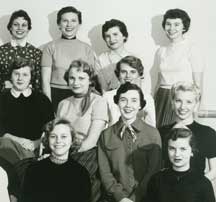 Individual groups then began adopting community organizations and providing thousands of dollars of aid each year. For example, the Delta Gammas have raised money for the Alexander Vision Clinic at Cook Children’s Medical Center since the sorority’s first meeting. Since the mid-1980s, the Tri Deltas have invited the community to decorate gingerbread houses and raise money for Cook Children’s Hospital. And the men of Pi Kappa Phi support Push America, helping those with disabilities.
Individual groups then began adopting community organizations and providing thousands of dollars of aid each year. For example, the Delta Gammas have raised money for the Alexander Vision Clinic at Cook Children’s Medical Center since the sorority’s first meeting. Since the mid-1980s, the Tri Deltas have invited the community to decorate gingerbread houses and raise money for Cook Children’s Hospital. And the men of Pi Kappa Phi support Push America, helping those with disabilities.
The variety of service projects is part of the fun: The Phi Kappa Sigmas host Phi Kap Man Day and the Sigma Chis take hats off for Derby Day for inter-fraternity competition.
According to Adams, these fund-raising efforts have become one of the strongest links in the TCU Greek system.
“The system is still here, still strong and healthy, because we do those things — service, philanthropy, mentors and mentorship.”
All this makes it hard to believe there was ever a controversy about Panhellenic groups on campus.
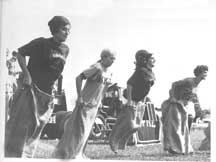 The idea that brought sororities and fraternities to TCU centered around declining enrollment. President M.E. Sadler reported to the Board of Trustees in 1954 that North Texas State University and Texas Tech had recently established these Greek groups, so why shouldn’t TCU?
The idea that brought sororities and fraternities to TCU centered around declining enrollment. President M.E. Sadler reported to the Board of Trustees in 1954 that North Texas State University and Texas Tech had recently established these Greek groups, so why shouldn’t TCU?
Just seven days after that report, Board Chairman Milton Daniel gave the go-ahead for several men to research, report and recommend whether or not these groups should become part of the fabric of TCU.
The issue stirred up a several months of heated debate on a campus previously void of real controversy. Student Dave Allred ’55, sparked the anti-Greek movement at TCU, circulating petitions and garnering hundreds of signatures in hopes that TCU would listen to his reasoning. After all, TCU offered an abundance of social organizations, from the Bryson Club and the Parabola Club to the Rodeo Association and the Singing Seminarians. Why follow suit with other colleges — first those in the Northeast, then trickling to Texas?
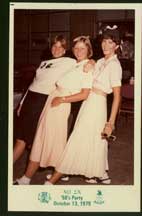 He wasn’t the only protester; some 120 names on a Dallas TCU Women’s Club petition was sent to Sadler, confirming that not all faces smiled upon the idea of Greek organizations.
He wasn’t the only protester; some 120 names on a Dallas TCU Women’s Club petition was sent to Sadler, confirming that not all faces smiled upon the idea of Greek organizations.
But when it came to a vote, most men came out smiling. Six months after the first Greek letters were worn on campus, board members approved bringing Greek societies to TCU, although it wasn’t unanimous — 16 gave the thumbs-up, seven opposed.
History doesn’t reveal who voted yay or nay, or why, but Vice President D. Ray Lindley’s proactive opinion of Greeks at TCU proved to hold a lot of weight. Although he listened to teary-eyed students who protested the idea, he also campaigned on the advantages of the fraternal groups on campus, citing their scholarship plans and the worthy charities they supported.
No one is certain who hung the first effigy from a tree in front of Sadler hall that read, “Democracy at TCU was tortured to death at 11 o’clock Thursday, Sept.23 (the date of the board’s final decision). But a group of prospective fraternity men who assumed it was Allred hung a life-size doll of Allred by Clark Hall with a sign that read, “Dave ‘Die-Hard’ Allred.” On the back: “Dave You Name It, I’m Against It Allred.”
Young Richard D. Duckworth ’55 had buddies from his hometown of St. Louis, Mo., who pledged Phi Delta Theta at other universities. He was a senior when the Greek issue began to brew.
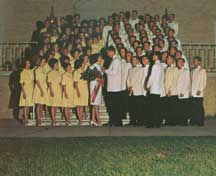 “I thought, ‘I’ll be a Phi Delt for the rest of my life even though I’ll only be in the chapter a few months before I graduate.’ I thought this was a great way to do it,” he recalled.
“I thought, ‘I’ll be a Phi Delt for the rest of my life even though I’ll only be in the chapter a few months before I graduate.’ I thought this was a great way to do it,” he recalled.
“Mr. [M.J.] Neeley was my rush man. He called me down to the Fort Worth Club for an interview, so I put on my best suit — the only one I had — and went down and told him all about myself. I convinced a bunch of other athletes to join, and they had the original 16 chosen by November or October.”
Today Duckworth lives across the street from his initiation ceremony site, St. Stephens Presbyterian Church on Merida, near campus. He recalls the the pastor praying over the 16 boys (four from each class), saying a few words about Phi Delta Theta, and presto! Duckworth was in one of TCU’s first fraternities.
The 1950s and ’60s were times of trial and error for the Greek system. Greek Review was inaugurated in 1957. In 1965, ground was broken for Worth Hills. Since the Board of Trustees would not allow fraternity and sorority housing off campus, the former golf course became home for sorority and fraternity dorms, complete with a cafeteria.
Rush was slow to find its place on the school calendar; for a while an informal spring event was held to accompany the fall parties. Greeks raised money during Campus Chest week, which featured a faculty/fraternity basketball game, Greek Review and now-politically incorrect “slave auctions” where each sorority put up two members as candidates . Fraternities collected coins through the Ugly Man Contest, in which students voted by dropping coins in the jar with the ugliest candidate’s picture attached.
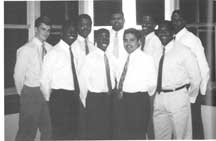 Historically Black fraternities, part of the National Pan Hellenic Council (NPHC), became a part of the Greek system in 1970, as Alpha Phi Alpha, Omega Psi Phi and Kappa Alpha Phi were officially recognized. The first NPHC sororities, Delta Sigma Theta and Alpha Kappa Alpha, followed suit five years later.
Historically Black fraternities, part of the National Pan Hellenic Council (NPHC), became a part of the Greek system in 1970, as Alpha Phi Alpha, Omega Psi Phi and Kappa Alpha Phi were officially recognized. The first NPHC sororities, Delta Sigma Theta and Alpha Kappa Alpha, followed suit five years later.
As the Greek system grew during the ’70s, leaders began wrangling with hazing issues. The Skiff reported in 1975 that the Student Organizations Committee passed a resolution saying any social fraternity found guilty of hazing would be banned from campus. Fraternity paddles, once used as a right of passage, are now just symbolic.
“The problems students face today are the same as in the past — alcohol and drugs, balancing freedom and academic success, hazing issues,” Adams said. “College is about balancing a culture and making sure you have your priorities right.”
In the ’80s TCU said hello to the Fijis and goodbye to the Kappa Deltas and Alpha Phis, which withdrew their chapters due to low numbers. The sisters of Chi Omega were hosting annual Apple Polishing parties, and the Tri Deltas could always be seen — as they still can — wearing yellow aprons and selling programs at football games.
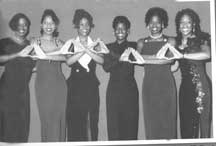 Girls who pledged sororities since the early ’90s remember running across the hill that leads to Worth Hills. Connecting the Rickel building and the bright awnings of Greek houses was a long, hallway-like stretch of frat boys, through which each girl had to run to be greeted by her new sisterhood on the other side.
Girls who pledged sororities since the early ’90s remember running across the hill that leads to Worth Hills. Connecting the Rickel building and the bright awnings of Greek houses was a long, hallway-like stretch of frat boys, through which each girl had to run to be greeted by her new sisterhood on the other side.
Many remember the days of Ribbon Dances, where sororities introduced their ribbon-bedecked pledges to the student body and faculty. Pledge lines, where pledges walked through a line-up of active sorority girls before receiving their bids, have faded into the grasses that front Colby Hall. Hazing, which, for some, was just part of the process, is now a serious legal matter.
What does the next half-century hold for TCU’s Greek system? Fraternities and sorority chapters will change as cultural and individual needs of society demands. TCU must remain on the cutting edge of the nation’s fraternities and sororities, said Campus Life Assistant Dean James Parker.
“The notion that one size fits all is dated and excludes smaller and newer fraternities and sororities from obtaining housing,” he said, adding that the future may bring a new look to Worth Hills. A cluster of different-sized chapter rooms and houses might be grouped to accommodate the needs of the entire Greek community on campus. Whatever it takes, Parker said, to give students a vested interest in TCU.
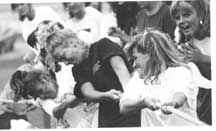 One thing is certain; with 50 years of history and still going strong, the TCU Greek system is still offering students many reasons to participate.
One thing is certain; with 50 years of history and still going strong, the TCU Greek system is still offering students many reasons to participate.
Tradition, said SAE Dak Hatfield ’97, is the cornerstone of Greek life of TCU.
“During pledgeship, we bonded with our class of pledges in ways you could never bond with anyone else,” he said. “It’s great to be a part of something where everything you do is based on tradition.”
Greeks then and now
The Originals
Established in 1954:
Alpha Delta Pi
Alpha Gamma Delta
Chi Omega
Delta Gamma
Kappa Alpha Theta
Kappa Delta
Kappa Kappa Gamma
Zeta Tau Alpha
Added 1956:
Pi Beta Phi
Delta Delta Delta
Fraternities in 1954:
Delta Tau Delta
Kappa Sigma
Phi Delta Theta
Phi Kappa Sigma
Sigma Alpha Epsilon
Sigma Chi
Sigma Phi Epsilon
Added 1956:
Lambda Chi Alpha
Today
National Panhellenic Conference (NPC) sororities:
Alphi Chi Omega
Alpha Delta Pi
Chi Omega
Delta Delta Delta
Delta Gamma
Kappa Alpha Theta
Kappa Kappa Gamma
Pi Beta Phi
Sigma Kappa
Zeta Tau Alpha
Interfraternity Council (IFC) fraternities:
Delta Tau Delta
Fiji
Kappa Sigma
Lambda Chi Alpha
Phi Delta Theta
Phi Kappa Sigma
Pi Kappa Phi
Sigma Alpha Epsilon
Sigma Chi
Sigma Phi Epsilon
National Pan Hellenic Council (NPHC) — [African-American]
Sororities:
Alpha Kappa Alpha
Delta Sigma Theta
Zeta Phi Beta
Fraternities:
Alpha Phi Alpha
Phi Beta Sigma
Multicultural Greek Council (MCG) — [Latino]
Sororities:
Sigma Lambda Alpha
Chi Upsilon Sigma
Fraternity:
Lambda Theta Phi

Your comments are welcome
Comments
Related Reading:
Features
Infographic: Minors
A wide variety of minors gives TCU students the chance to add depth to their majors or dive into new areas.
Features
Venture Capitalism 101
MBA students connect investors and startups in a Neeley program.